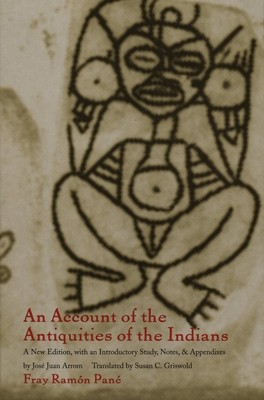
- We will send in 10–14 business days.
- Author: Fray Ramon Pané
- Publisher: Duke University Press
- ISBN-10: 0822323478
- ISBN-13: 9780822323471
- Format: 15 x 23.4 x 0.8 cm, softcover
- Language: English
- SAVE -10% with code: EXTRA
Reviews
Description
Accompanying Columbus on his second voyage to the New World in 1494 was a young Spanish friar named Ramón Pané. The friar's assignment was to live among the "Indians" whom Columbus had "discovered" on the island of Hispaniola (today the island shared by Haiti and the Dominican Republic), to learn their language, and to write a record of their lives and beliefs. While the culture of these indigenous people-who came to be known as the TaÃno-is now extinct, the written record completed by Pané around 1498 has survived. This volume makes Pané's landmark Account-the first book written in a European language on American soil-available in an annotated English edition.
Edited by the noted Hispanist José Juan Arrom, Pané's report is the only surviving direct source of information about the myths, ceremonies, and lives of the New World inhabitants whom Columbus first encountered. The friar's text contains many linguistic and cultural observations, including descriptions of the TaÃno people's healing rituals and their beliefs about their souls after death. Pané provides the first known description of the use of the hallucinogen cohoba, and he recounts the use of idols in ritual ceremonies. The names, functions, and attributes of native gods; the mythological origin of the aboriginal people's attitudes toward sex and gender; and their rich stories of creation are described as well.
EXTRA 10 % discount with code: EXTRA
The promotion ends in 19d.06:34:19
The discount code is valid when purchasing from 10 €. Discounts do not stack.
- Author: Fray Ramon Pané
- Publisher: Duke University Press
- ISBN-10: 0822323478
- ISBN-13: 9780822323471
- Format: 15 x 23.4 x 0.8 cm, softcover
- Language: English English
Accompanying Columbus on his second voyage to the New World in 1494 was a young Spanish friar named Ramón Pané. The friar's assignment was to live among the "Indians" whom Columbus had "discovered" on the island of Hispaniola (today the island shared by Haiti and the Dominican Republic), to learn their language, and to write a record of their lives and beliefs. While the culture of these indigenous people-who came to be known as the TaÃno-is now extinct, the written record completed by Pané around 1498 has survived. This volume makes Pané's landmark Account-the first book written in a European language on American soil-available in an annotated English edition.
Edited by the noted Hispanist José Juan Arrom, Pané's report is the only surviving direct source of information about the myths, ceremonies, and lives of the New World inhabitants whom Columbus first encountered. The friar's text contains many linguistic and cultural observations, including descriptions of the TaÃno people's healing rituals and their beliefs about their souls after death. Pané provides the first known description of the use of the hallucinogen cohoba, and he recounts the use of idols in ritual ceremonies. The names, functions, and attributes of native gods; the mythological origin of the aboriginal people's attitudes toward sex and gender; and their rich stories of creation are described as well.


Reviews